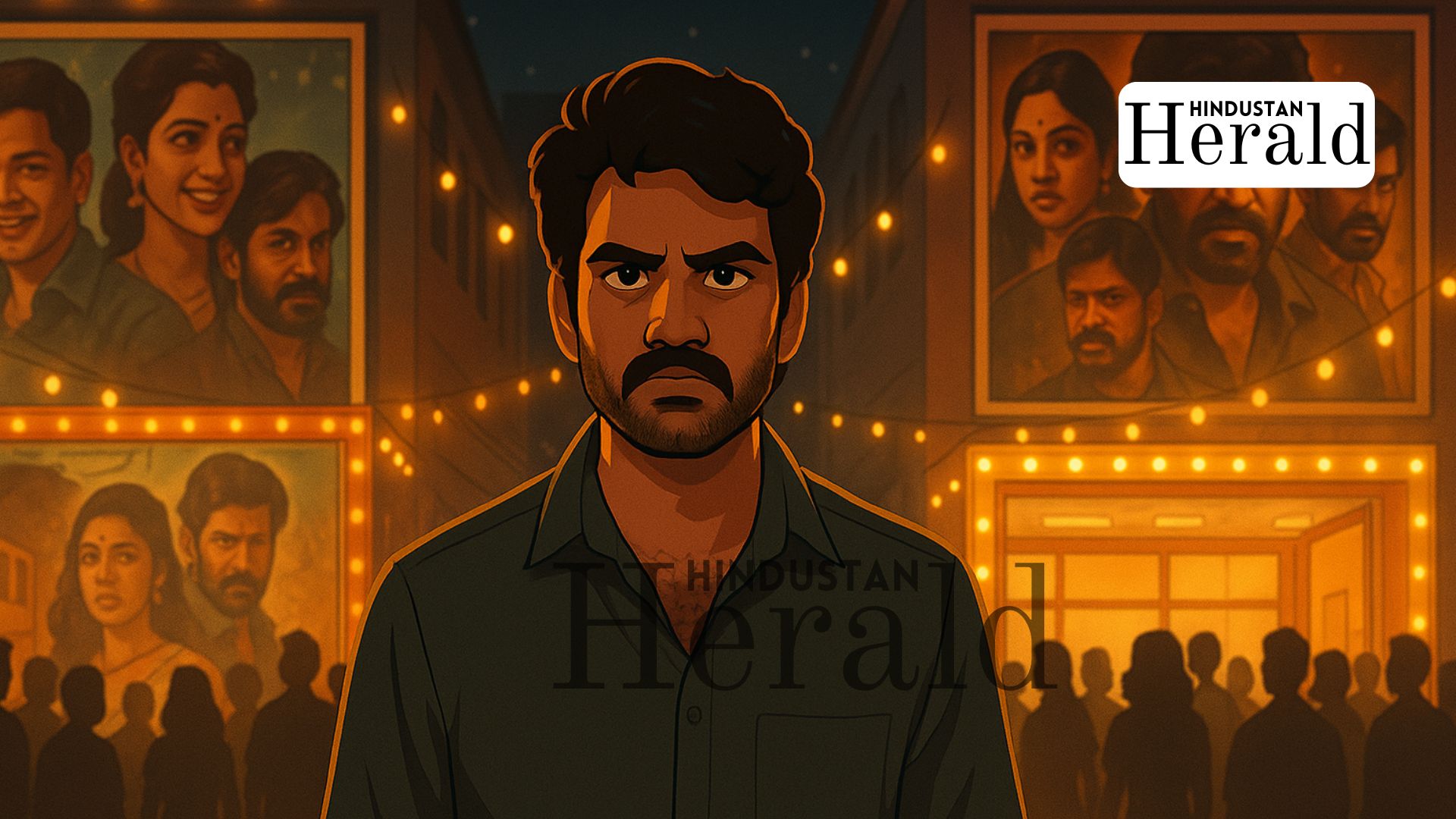Chennai, October 18: When Kiran Abbavaram’s new Telugu film K Ramp opened in theatres this Diwali weekend, the actor expected applause and a solid run across South India. What he got instead was a frustrating lesson in how regional cinema still wrestles with invisible borders, the kind that aren’t drawn on maps but on movie screens.
A Release Caught Between Markets
K Ramp, directed by Jains Nani and starring Abbavaram alongside Yukti Thareja, hit theatres on a Saturday, not the usual Friday. The makers said it was a calculated move, hoping the extra day would help the film ride the festive wave. But by evening, it was clear the gamble hadn’t paid off everywhere.
In Tamil Nadu, where the Telugu star has a small but vocal following, the movie barely found space. Abbavaram sounded visibly dejected during promotions, pointing out that K Ramp had been given far fewer screens than Tamil film Dude, which was releasing around the same time, even though Dude had managed a much bigger rollout in Andhra Pradesh and Telangana.
“Telugu films don’t get the same chance in Tamil Nadu that Tamil films get in our states,” he said, in what quickly turned into one of the most shared quotes of the week among South film watchers.
His frustration didn’t go unanswered. Ravi Shankar, the producer of Dude, responded that it wasn’t biased but business. “Screen counts depend on demand,” he told The Times of India. “Every film fights for its audience.”
Maybe he’s right. But the argument exposed a wound that’s been festering for years, one that flares up every time a film crosses state lines.
Why Telugu Films Struggle Across the Border
Talk to anyone in the trade, and they’ll tell you it’s not easy for Telugu films to find breathing room in Tamil Nadu’s crowded release calendar. Every major Tamil star has loyal exhibitors, fixed slots, and aggressive promotional networks. Even mid-tier Tamil films get preference, while Telugu titles, unless they carry a Pushpa or Baahubali-level buzz, have to fight for leftover screens.
This time, the numbers tell their own story. According to distributors quoted by The Times of India, Dude was shown in nearly twice as many theatres as K Ramp in Tamil Nadu, including in Chennai, Coimbatore, and Madurai. That imbalance effectively sealed K Ramp’s fate before the first ticket was sold.
A distributor in Hyderabad put it bluntly: “When your morning shows are missing in key multiplexes, you’re already out of the race. By the time word-of-mouth kicks in, the next movie’s taken your spot.”
The situation isn’t new, but it feels more glaring now because the southern industries are supposed to be more connected than ever. Actors criss-cross languages. OTT platforms erase borders. But inside theatres, regional loyalties still decide what people get to watch.
Kiran Abbavaram’s Fight for Space
For Abbavaram, this wasn’t just about one release. His career has been a patchwork of near-hits and misses SR Kalyanamandapam gave him a strong start, Vinaro Bhagyamu Vishnu Katha earned goodwill, but he’s yet to land a film that makes him unshakably bankable.
K Ramp was meant to change that. Set partly in Kerala, the movie tries to be a youthful action drama with social undertones, the kind that appeals across state lines. The marketing leaned on vibrant music and college humour. On paper, it had the ingredients of a mid-range festival entertainer.
But festival seasons are brutal. With Dude and Bhool Bhulaiyaa 3 vying for the same audience, K Ramp got squeezed out in both visibility and buzz. Even in Telugu states, theatres were split across multiple titles. The film’s opening numbers reflected that strain was respectable in pockets, thin elsewhere.
When Cinema Meets Politics of Space
Every state has its own rules, some official, some quietly enforced. In Tamil Nadu, theatre owners often reserve weekends for local-language films first. Distributors defend it as survival logic: “Our audience base is primarily Tamil; why would we give priority to a film with limited pull here?”
Telugu producers counter that it’s a chicken-and-egg problem. Without enough shows, a film can’t build that pull in the first place. What hurts, they say, is the hypocrisy that Tamil films are welcomed warmly in Telugu states, often with dubbed versions and joint promotional campaigns.
Film critic Sreedhar Pillai explained it well in a recent analysis. “In Tamil Nadu, release slots are tightly guarded. Unless a Telugu film is already a phenomenon, it won’t get space. But the irony is, how can a film become a phenomenon without exposure?”
The imbalance, he added, is both commercial and cultural. “It’s about market confidence. Tamil distributors trust their audience to show up for local stars, not outsiders.”
Online Firestorm and Industry Reactions
Once Abbavaram’s comments made it online, social media took over. On X, hashtags like #SupportTeluguCinema trended in Hyderabad, while Chennai users accused Telugu fans of exaggerating. Some called it insecurity; others said the actor had every right to be upset.
Ravi Shankar tried to douse the fire, repeating that Dude’s performance justified its wider release. “We didn’t block anyone’s screens,” he said. “It’s just business logic. Whoever pulls crowds gets preference.”
Yet, there’s no denying that the optics stung. To many Telugu viewers, the sight of their local hero being sidelined in a neighbouring market during Diwali, a festival both states share, felt symbolic of a larger imbalance.
What the Reviews Said
The reviews didn’t exactly help. Critics across platforms, Moneycontrol, Telugu360, 123Telugu, and M9 News all landed somewhere between 2 and 2.75 stars. They liked Abbavaram’s energy, appreciated the music, but found the film itself uneven. “No Ramp, All Cramp,” read one particularly biting headline.
Most pointed to the same issues: a predictable plot, forced emotion, and too much loud comedy. It wasn’t the kind of content that could muscle its way into new markets on sheer quality. Still, even an average film, many argued, deserves a fair shot at visibility.
The Larger Question
It’s ironic that at a time when South Indian cinema has become a national force with Telugu and Tamil films conquering Hindi-speaking markets, they still struggle to share space. The divide isn’t creative anymore; it’s structural.
Cinema, for all its glamour, runs on distribution monopolies and unwritten codes. During festivals, those rules tighten. Tamil Nadu protects its own releases, and Andhra does the same during Sankranti. But as audiences evolve and digital reach expands, the old model looks increasingly out of step.
Critic Baradwaj Rangan recently remarked that theatres could lose younger audiences if they keep drawing these lines. “Viewers now jump between languages on streaming apps every week,” he said. “Theatres risk becoming more regional while audiences become more universal.”
What Lies Ahead
K Ramp may not turn into a box-office story worth celebrating, but it’s sparked an uncomfortable, necessary conversation. Behind the polite statements and social-media sparring lies a bigger question: Can South India’s film industries truly coexist as a united creative force, or will they continue to guard their linguistic territories?
For now, both the Tamil and Telugu film chambers are reportedly discussing new screening agreements for 2026, an attempt to prevent exactly this kind of clash. Whether those talks lead anywhere remains to be seen.
Kiran Abbavaram, for his part, has maintained a professional demeanor since the controversy. He thanked fans, admitted the release was “a learning curve,” and moved on to promote his next project. Still, his voice lingers in the background of this debate, a reminder that fair play in cinema isn’t just about content, it’s also about access.
As one trade insider put it late last night, almost with a sigh, “We keep talking about pan-India cinema. But when it comes to screens, we’re still stuck in pan-district politics.”
Stay ahead with Hindustan Herald — bringing you trusted news, sharp analysis, and stories that matter across Politics, Business, Technology, Sports, Entertainment, Lifestyle, and more.
Connect with us on Facebook, Instagram, X (Twitter), LinkedIn, YouTube, and join our Telegram community @hindustanherald for real-time updates.
Covers films, television, streaming, and celebrity culture with a focus on storytelling trends.






